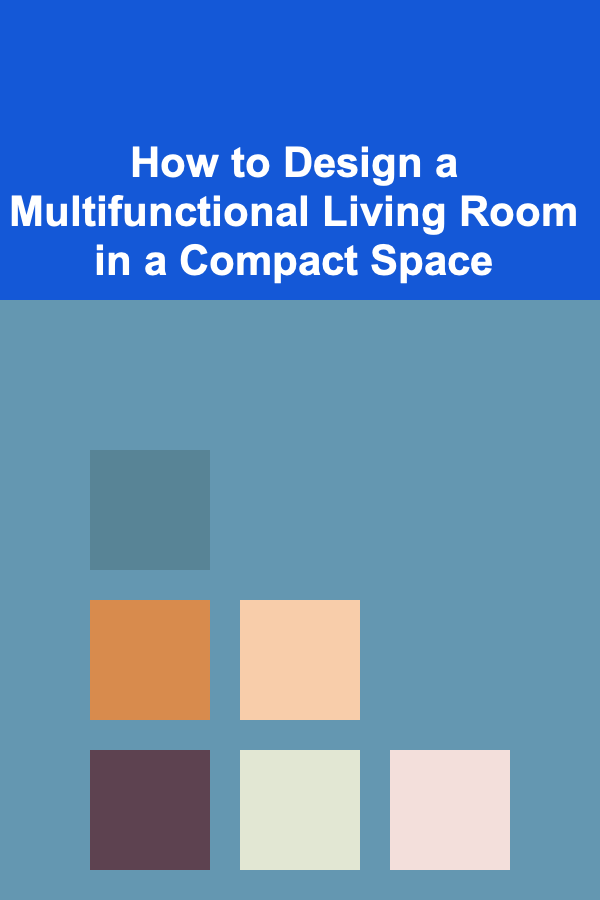
How to Design a Multifunctional Living Room in a Compact Space
ebook include PDF & Audio bundle (Micro Guide)
$12.99$11.99
Limited Time Offer! Order within the next:

Designing a living room in a compact space can be a rewarding yet challenging task. In smaller homes or apartments, maximizing every square foot is essential to create a functional, comfortable, and stylish environment. A living room, being the central space where you entertain, relax, and often work, needs to serve multiple purposes. The key to successfully designing a multifunctional living room lies in thoughtful furniture selection, smart storage solutions, and the right use of color and light.
In this article, we will explore the principles, strategies, and practical tips for designing a multifunctional living room in a compact space. Whether you're living in a small apartment, a studio, or a house with limited square footage, these ideas will help you optimize the space for a variety of activities without feeling cramped.
Understanding the Needs of a Multifunctional Living Room
Before diving into design details, it's important to understand the various roles a living room can play in a compact space. A multifunctional living room must adapt to different needs throughout the day. Some common functions of a living room might include:
- Relaxation space: A cozy area for watching TV, reading, or just unwinding.
- Entertainment zone: A place to host guests for dinner, drinks, or socializing.
- Work or study area: For those who work from home or need a space for school-related activities.
- Storage: Maximizing the use of available storage space to keep clutter at bay.
The goal is to ensure that the room remains fluid and adaptable, allowing each of these functions to coexist seamlessly without sacrificing style or comfort.
Start with a Clear Vision and Plan
The first step in designing a multifunctional living room is to establish a clear vision. What activities will take place in the room? How much space is available for each function? Creating a floor plan will help identify key areas in the room where each function can be prioritized.
2.1. Zoning the Space
In a compact living room, zoning is a practical way to separate distinct areas within the same space. Zoning can be done through furniture placement, rugs, lighting, and even different wall treatments. For example, you might place a sofa in one section of the room for relaxation and then use a bookshelf or a small divider to create a dedicated workspace in another area.
Zoning doesn't mean creating physical walls but rather designing subtle separations that serve different functions. Here are a few zoning strategies:
- Furniture placement: Arrange furniture in a way that naturally divides the space. For example, place a sofa facing a TV or window to create a lounging area, while positioning a desk or a small dining table away from this focal point.
- Use of rugs: Rugs help visually separate different zones within a room. Place a rug beneath your seating area to create a cozy living space, and use another rug under a desk or dining table to define the work or eating zone.
- Lighting: Varying the lighting is another way to create zones. Use softer, ambient lighting for relaxation areas and brighter task lighting for workstations.
By clearly defining the zones, you can optimize your compact space to serve various needs without overwhelming the room.
Select Furniture that Multitasks
Furniture is the foundation of any living room, and in a small space, choosing versatile and space-saving pieces is essential. The goal is to select furniture that serves more than one purpose, allowing you to maximize the room's functionality without cluttering it with unnecessary pieces.
3.1. Sofa Beds and Modular Seating
A sofa bed is an excellent choice for compact living rooms where you may occasionally have guests stay over. During the day, it functions as a comfortable seating area, and at night, it transforms into a bed. This saves you from needing both a couch and a separate guest bed.
Modular seating systems also offer flexibility. Many modular sofas can be rearranged to suit your needs, whether it's for a movie night, lounging, or hosting a group. Some modular pieces even include built-in storage, providing additional space to stow away blankets, cushions, or books.
3.2. Foldable or Expandable Dining Tables
For small living rooms that need to accommodate dining and entertaining, foldable or expandable dining tables are lifesavers. These tables can be compact when not in use, but can easily be extended to accommodate more guests when needed. Folding tables can also be stored away when you need extra space for other activities, like exercise or playtime.
3.3. Wall-Mounted and Foldable Desks
If your living room serves as a workspace, consider a wall-mounted or foldable desk. These types of desks can be tucked away when not in use, maintaining the openness of the room. Wall-mounted desks are particularly effective in compact spaces, as they don't take up floor space and can often be installed at an ideal height for work.
3.4. Storage Furniture
Maximizing storage in a compact living room is critical for maintaining an organized and clutter-free environment. Invest in furniture with built-in storage options, such as:
- Coffee tables with storage: Many coffee tables come with hidden compartments or drawers where you can store remote controls, books, or other small items.
- Ottomans with storage: Ottomans are versatile pieces that can serve as footrests, extra seating, or even as additional storage for blankets and magazines.
- Bookshelves and cabinets: Wall-mounted bookshelves or floating cabinets can provide storage without taking up valuable floor space.
Look for furniture that doubles as both storage and seating. For example, a bench with a cushion on top can act as both a place to sit and a hidden storage unit.
Opt for Light Colors and Minimalistic Designs
In a compact space, the color palette and design of the furniture can make a significant difference in how the room feels. Lighter colors help open up a room, making it appear larger and airier, while dark tones can have the opposite effect, making the space feel more confined.
4.1. Color Palette
Choose light neutrals like white, beige, light gray, and soft pastels for the walls and larger furniture pieces. These colors reflect more light, making the room feel brighter and more spacious. You can also add pops of color through accessories, such as throw pillows, artwork, or curtains.
The use of mirrors can also create a sense of openness. Mirrors reflect light and create the illusion of more space, which is especially useful in a small living room. Consider incorporating a large mirror as a statement piece or placing several smaller mirrors throughout the room.
4.2. Minimalistic Furniture
A minimalist design approach is ideal for small spaces. Keep furniture sleek and simple, with clean lines and a functional design. Avoid bulky, heavy pieces that can overwhelm the room and instead opt for furniture with an open, airy design.
Additionally, consider furniture that serves more than one purpose, as mentioned earlier. Multi-functional furniture reduces clutter and simplifies the room's layout. Pieces that are minimal in design will also contribute to a calming, less cluttered aesthetic.
Maximize Vertical Space
When working with a small footprint, it's essential to make use of the vertical space in your living room. By building upwards, you can create storage, display areas, or even additional seating without encroaching on the floor area.
5.1. Tall Shelving Units
Tall shelving units take advantage of vertical space and allow you to store books, display decorative items, or organize other belongings without taking up much floor space. Floating shelves are another great option, as they give the room an open feel while offering storage.
5.2. Wall-Mounted Hooks and Racks
Wall-mounted hooks, racks, and pegboards can be used to store bags, coats, keys, or other items that might clutter up the floor. These pieces can serve both practical and decorative purposes, providing easy access to essentials while maintaining a tidy living room.
5.3. Overhead Storage
Consider installing overhead storage units or cabinets above your furniture. These can store less frequently used items, such as seasonal decorations or extra linens, without cluttering up the room. This approach keeps the storage out of sight but still easily accessible.
Lighting Strategies for Compact Spaces
Lighting plays an essential role in making a small living room feel larger and more inviting. In compact spaces, it's essential to layer your lighting to create different moods and ensure that every area of the room is well-lit.
6.1. Layered Lighting
Use a combination of ambient, task, and accent lighting to create a well-lit living room. Ambient lighting provides general illumination, while task lighting focuses on specific activities, like reading or working. Accent lighting can be used to highlight artwork, plants, or other decorative elements.
6.2. Use of Natural Light
Maximize natural light by using light curtains or blinds that allow sunlight to pour into the room. Large windows or glass doors are ideal, but if you don't have much natural light, mirrors can help reflect it around the room, making the space feel more open.
6.3. Adjustable Lighting Fixtures
Invest in adjustable or dimmable lighting fixtures to control the intensity of the light. This flexibility ensures you can create the perfect atmosphere, whether you're working, relaxing, or entertaining guests.
Personalizing the Space
Lastly, it's important to infuse your personal style into your compact living room. Personalization is key to making the space feel like home. Use artwork, plants, textiles, and accessories to create a room that reflects your tastes and interests.
- Artwork and prints: Wall art can add character and personality to your living room. Choose art that complements the overall color scheme and vibe of the space.
- Plants: Adding greenery to your living room not only makes the space feel fresher and more inviting but also helps improve air quality.
- Textiles: Throw blankets, cushions, and rugs bring warmth and texture to the room, making it more comfortable and visually appealing.
Conclusion
Designing a multifunctional living room in a compact space is all about maximizing the potential of every inch. With careful planning, the right furniture, smart storage solutions, and a thoughtful layout, you can create a space that serves multiple purposes without feeling crowded or chaotic. By embracing versatile furniture, clever zoning, and light colors, you can transform a small living room into a stylish, functional, and comfortable area that caters to all your needs.

How to Choose the Best Light Fixtures for Your Home's Style
Read More
How to Gather and Organize Supporting Documents for Your Grant Application
Read More
How to Plan for Financial Independence in Your 40s
Read More
How to Prioritize Home Expenses When You're on a Tight Budget
Read More
The Ultimate Guide to Cheap Travel Options for Every Type of Traveler
Read More
How to Use Flash for Professional Results
Read MoreOther Products

How to Choose the Best Light Fixtures for Your Home's Style
Read More
How to Gather and Organize Supporting Documents for Your Grant Application
Read More
How to Plan for Financial Independence in Your 40s
Read More
How to Prioritize Home Expenses When You're on a Tight Budget
Read More
The Ultimate Guide to Cheap Travel Options for Every Type of Traveler
Read More